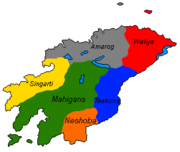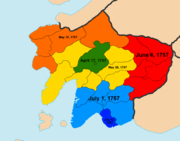History of Laiatan
| This page is a work in progress by its author(s) and should not be considered final. |
Laiatan has a long and extensive history, bloodshed occurring quite often throughout it.
Contents
Tribal Laiatan
The tribes that made up Laiatan before its unification are thought to date from the Lupine Bronze Age. From their origins in what is now the province of Okezuka, the tribes in all directions away from the coast. By the 6th century AD, four major tribal groups had dispersed themselves across the territory. These tribes were split into smaller individual tribes, most of which had confederation-styled governments.
One Mahigan tribe, called the Lai, were considered expert diplomats and had an elite military. These two factors helped push the Lai tribe into regional dominance through the conquest of their neighbors diplomatically and militarily. In 602 AD, under the leadership of Svetlav Kosma, the tribe consolidated itself from a confederation into a much more centralized state with Kosma as its leader. He assumed the title of Duke, and named the territory he controlled after his people, Lai.
The Lai state and expansion
Lai largely maintained its borders for 300 years before making serious expansion into neighboring nations and confederations that made up Laiatan. The nation expanded under the control of Dorofei Kosma in 990 AD. The nation's army was well equipped and strong, allowing it to easily overrun the smaller, neighboring confederations. Many of these confederations were still 'tribal', allowing a rather easy takeover of the territory by Lai armies. In ten years, Lai more than tripled in size. This expansionist attitude carried on after Dorofei Kosma's death in 1015 AD by his 16 year old son, Dorofei II. By 1033, Dorofei II ruled most of the Mahigan tribes in central Laiatan. About 18 years later in 1051, Dorofei II had unified the Mahigan people. Volkgoroda, a once tiny Mahigan fishing village was growing exponentially at this time as a major trading and cultural hub, was chosen to seat the new Kingdom's government.
The kingdom was incredibly popular among the masses for the 321 years of its existence, mostly due to the large amount of freedoms the population was given. During this time a new code of law was written, focusing on retribution and ensuring that the punishment fit the crime. For example, thieves had their hand removed, citizens who injured other citizens were beaten, and murderers were executed by hanging or beheading. The system maintained its swift, severe and certain punishments, fueling deterrence. The current code of law in place can trace its roots directly back to this code of law.
Over the next 321 years, the kingdom continued to expand in all directions, finally including other 'breeds' into the kingdom. This expansion continued through conquest and annexation until April 6, 1432, when Artemiy Veselovsky crowned himself 'King of the Lupines', taking the title Korol, which means emperor in Laiatanese.
Laiatanese Empire
After the Empire's establishment in 1432, the country did not expand either militarily nor diplomatically for another 63 years. Under the leadership of Artyom II, the country proceeded to expand eastward in 1493 through a large scale military invasion of Teekon territory known as Teekonistan, which was attempting to unite the Teekon breed. The empire also started making more pushes into southern Laiatan. By the end of the 1495, most of Teekonistan was under the total control of Laiatan.
The country expanded again when it got its first Korolina, Katherine. She is today commonly called Katherine the Great, one of the few Laiatanese korols to be awarded the title. Taking power in 1545, Katherine heavily built up the military before launching massive military attacks against the remaining territory of Teekonistan, as well as Neshobastan in 1448. These areas came under total control of Laiatan in 1550. The final expansion came in 1560, when Neshobastan requested integration into the empire, which was accepted by Katherine. The borders Katherine established would go on to be the borders of the Federation.
The empire remained strong and popular until the ascension of Yuri Kamenev on December 8, 1733. The adopted son of Korol Valentin III, Yuri took the throne after his father's natural death due to his step-brothers' deaths several years before due to tuberculosis. Almost immediately, Yuri began cracking down on the country. He saw it as corrupt and being far too free for any good to come of it, despite the boom in the economy and population that was occurring at the time. Liberties were stripped from the people, and started a policy of seizing profitable businesses.
It's believed now that Yuri may have had schizophrenia, as he would often respond to 'voices' and was often delusional up until his last days as Korol.
Laiatanese Revolution
The first shots of the revolution were fired by guerrilla fighters under the command of Aleksy Zukov in northern Vysoki during an attack on a small detachment of imperial troops marching to a border town to seize the townspeople's weaponry. The attack resulted in the deaths of four imperial soldiers and eleven guerrilla fighters. News of the attack spread like wildfire, and thousands of people across the province took up arms and flocked to Zukov's banner. The revolution continued to grow in the Vysoki mountainside, attacks on imperial troops and shipments increasing.
As 20,000 troops were dispatched to Vysoki to put down the revolution, small groups of pro-Zukov fighters began popping up across the country, and flocked to help in the fight for Vysoki. After a two and a half year struggle, Vysoki had successfully been purged of all imperial soldiers and governance. Zukov was appointed governor of the province and put in charge of its fledgling army. Zukov sent an ultimatum to Yuri the Terrible, demanding he step down and hand control to the people, or "face execution when the revolution comes through [his] front door." Yuri declined this ultimatum, responding with more troops to Vysoki. In response to Yuri declining, Vysoki announced its secession from the empire.
Zukov's power base grew as he fought back against Yuri's forces, liberating several other northern provinces. By 1750, 15 of the 24 provinces of the country had seceded and joined Zukov's cause. Three years later on March 8, 1753, the largest and bloodiest battle of the war took place outside the gates of Volkgoroda. Almost 15,000 imperial soldiers were killed, as well as nearly 20,000 revolutionaries. On August 1, 1753, the revolutionaries finally managed to bring down the gates of the city. Nearly 150,000 revolutionaries swarmed into the city, looting government owned businesses as well as the homes of members of the government. The revolutionaries swarmed the Royal Palace, finding it abandoned. Zukov managed to get there before it was looted and established a new military government, promising the freedoms the population once had. After this declaration, Zukov arrested each member of government still in the city. Two days later they were tried and executed in Revolution Square, formerly known as Korol Square.
Three days later, Yuri and his family were captured by revolutionary forces at an inn a few miles from the Vulshainian border. After what many consider to be a kangaroo court, Yuri and his entire family were executed on the inn wall.
With the capital finally under his control, Zukov established his military government and began the process of rebuilding the war torn country.
Zukov's Laiatan
Aleksy Zukov established the Liberation Council and took the title of premier, while he awarded his five commanders with "parliamentary" positions with the title 'Liberator.' Effectively a dictatorship, the Council worked hard in its first year to put down royalists and anyone who they considered to be a threat to the future of the country. This policy remained in place for about a year, though the Ipatiev Death Squad (IDS) continued to operate without the consent of the Council until early 1756 when the squad's leaders were arrested and executed for plotting against the state. Reports indicate that the IDS executed nearly 4,000 people.
The Liberation Council undertook the task of writing a constitution for a country that never had a written supreme law document. It had always been an unwritten set of rules all leaders of the country followed until Yuri the Terrible. Therefore, the Council looked at the unwritten rules and transferred them into a single document, with a few changes. Some of the first amendments included the freedom of speech, freedom of the press, freedom of religion, as well as the right for habeas corpus unless suspended under extraordinary circumstances (invasion, rebellion, etc.). It also established the country's legislative, executive and judicial branches.
The Constitution was completed and signed on April 17, 1757, officially creating the Laiatanese Federation. The Liberation Council passed along copies to each of the provinces for ratification. Volkapita and the Federal City of Volkgoroda were the first to ratify the constitution. The constitution was not ratified by all 24 provinces until July 12, 1757, when it was ratified by Vostpo.
Laiatanese Federation
The Laiatanese Federation was truly complete on October 15, 1757, when the country overwhelmingly elected Aleksy Zukov as its first president and members of the Federation Assembly. Zukov's first term revolved around completing the job he started with the Liberation Council, as well as strengthening the country as a whole. He was elected again in 1761, which brought along a period of calmness and prosperity. The country began opening up in the region, establishing diplomatic missions in several countries.
The peace the country finally achieved survived for more than a hundred years until 1893, when it was invaded by neighboring Vulshain. After a brutal, five year war, Laiatan came out on top. Peace would continue between the two countries until the 21st century. Laiatan would remain at peace for 58 years until the 1956 October Putsch, which was the attempted overthrow of the federal government by pro-communist elements of the military, operating under the name of the New Laiatanese Federation. This was crushed by loyalist elements of the military thirty days later. Mostly focused around Volkgoroda, Kosma, and Letov, brutal street fighting occurred between units, resulting in nearly 5,000 dead on both sides.
Peace returned until the 1980s when the country invaded its neighbor Vulshain to put an end to the violent revolution occurring in the country. After a swift invasion and fight, Laiatan overthrew the dictatorship and reinstated the monarchy. It would remain in the country for a few years after before pulling out. A similar situation happened in 2003, when the country was torn apart in a civil war. Like during the 1980s, the country returned to put a stop to the fighting and backed the current government.
In 2010, the country launched a joint-SITO operation with Vulshain into Rygard to remove the dictatorship. The country is still operating the island with Vulshain, though plans have been written up to pull Laiatanese troops out of Rygard by the end of 2014. This has already begun, with 10,000 troops returning home permanently in May of 2014.
| Laiatanese Federation | ||
|---|---|---|
| Main article: Laiatan | ||
| Important Topics: Culture ♦ Lupine ♦ Laiatanese language ♦ Mahitou ♦ Laiatanese korona ♦ Defense Forces | ||
| Government: Cabinet ♦ Federation Assembly ♦ Federal Council ♦ People's Council ♦ President ♦ Supreme Federal Court ♦ Political Parties | ||
| History: Pre-Mahigan Laiatan ♦ Kingdom of Laiatan ♦ Laiatanese Empire ♦ Laiatanese Junta ♦ Laiatanese Federation | ||
| Important Figures (Past and Present): Yuliya Surkova ♦ Zakhar Kreskov ♦ Aleksey Zukov ♦ Yuri IV ♦ Katerina I ♦ Nika Alkaev ♦ Yura Lainov | ||



